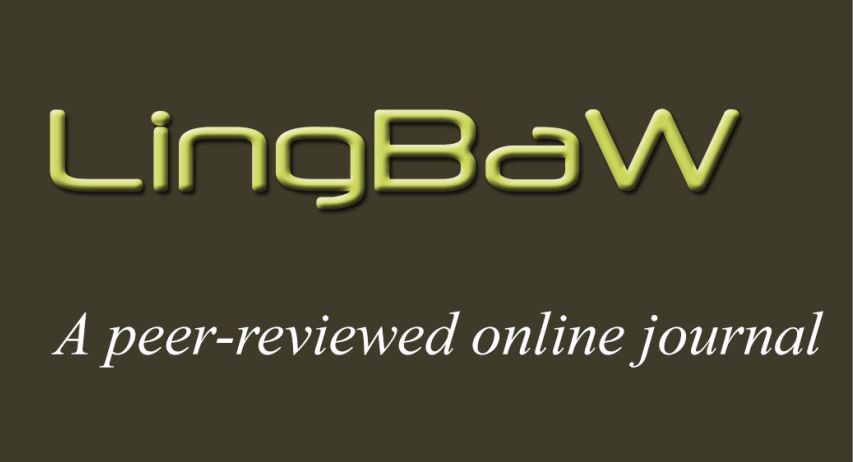Pragmatic marker to in Hausa (West Chadic, A.1; Nigeria)
Patryk Zając
Department of African Languages and Cultures, Faculty of Oriental Studies, University of Warsaw , Polandhttps://orcid.org/0000-0002-8004-8738
Abstract
In Hausa language function words contribute to sentence structure mainly on the syntactic level. They can specify the attitude or mood of the speaker. The broad class of function words includes a sub-class of items known as Pragmatic Markers (PMs). So far interpretations of PM to in Hausa were based on its semantic rather than structural contributions to the utterance content. There is a lack of a closer look on to from the pragmatic perspective. The aim of this article is to demonstrate how the interpretation of to within the framework of PM can contribute to describing this item’s functions in discourse in a more precise way, i.a. for the purpose of preparation of resources for studying the Hausa language by foreigners such as bilingual dictionaries. I propose the interpretation of to as a PM with the binary category of procedural and representational meaning. It will be demonstrated with the examples extracted from radio conversations that PMs framework allows to comprehensively describe to marker in terms of its contextually determined functions and meanings.
Keywords:
Pragmatic Marker, Hausa, radio, conversation, modal particleReferences
Abraham, R. C. 1962. Dictionary of the Hausa Language. 2nd edn. London: University of London Press.
Abraham, W. (ed.). 1991. Discourse Particles. Amsterdam: John Benjamins Publishing Company.
Adamu, M. 1976. The spread of the Hausa culture in West Africa 1700-1900. Savanna 5(1): 3–13.
Amfani, A. H., A. Umar, M. Abdoulaye, M. B. Attouman, A. I. Malumfashi, and M. Munkaila (eds.). 2011. A unified standard orthography for the Hausa language: Nigeria, Niger, Cameroon, Ghana and Chad (Monograph Series no. 241). Cape Town, South Africa: Centre for Advanced Studies of African Society (CASAS).
Ariel, M. 1994. Pragmatic operators. The Encyclopaedia of Language and Linguistics. Oxford: Pergamon Press.
Austin, J. L. 1962. How to Do Things with Words. Cambridge: Cambridge University Press.
Azi, Y. 2018. Investigating Arabic Pragmatic Markers in spoken discourse. International Journal of Linguistics 10(2): 48–72. (Crossref)
Baldi, S. 2008. Dictionnaire des emprunts arabes dans les langues de l’Afrique de l’Ouest et en suahili. Paris: Karthala.
Bargery, G. P. 1934. A Hausa-English Dictionary and English-Hausa Vocabulary. London: Oxford University Press.
Bazzanella, C. 1990. Phatic connectives as intonational cues in contemporary spoken Italian. Journal of Pragmatics 14: 629–647. (Crossref)
Bidaoui, A. 2015. Discourse Markers of clarification and causality in Maghrebi and Egyptian dialects: a socio-pragmatic perspective. University of Illinois at Urbana-Champaign PhD diss. (Crossref)
Blakemore, D. 2002. Relevance and Linguistic Meaning: The Semantics and Pragmatics of Discourse Markers. Cambridge: Cambridge University Press. (Crossref)
Brinton, L. 1996. Pragmatic Markers in English: Grammaticalization and Discourse Functions. Berlin & New York: Walter de Gruyter. (Crossref)
Clayman, S. E., and V. T. Gill. 2012. Conversation Analysis. In J. P. Gee, and M. Handford (eds.), The Rutledge Handbook of Discourse Analysis, 120–134. London & New York: Routledge.
Dascal, M., and T. Katriel. 1977. Between semantics and pragmatics: the two types of but – Hebrew aval and ela. Theoretical Linguistics 4: 143–172. (Crossref)
Delafosse, M. 1901. Manuel de la langue haoussa. Paris: Libraire Orientale et Américaine.
Dijk, T. A. van. 1979. Pragmatic connectives. Journal of Pragmatics 3: 447–456. (Crossref)
Dunn, A. S. 1990. The Pragmatics of Selected Discourse Markers in Swahili. University of Illinois at Urbana-Champaign PhD diss.
Duszak, A. 1998. Tekst, dyskurs, komunikacja międzykulturowa [Text, discourse, intercultural communication]. Warszawa: Wydawnictwo Naukowe PWN.
Eberhard, D. M., G. F. Simons, and C. D. Fennig (eds.). 2022. Ethnologue: Languages of the World. 25th edn. Dallas, Texas: SIL International. https://www.ethnologue.com/
Erman, B. 1987. Pragmatic Expressions in English. A Study of ‘You know’, ‘You see’ and ‘I mean’ in Face-to-Face Conversation. Stockholm: Almqvist and Wiksell.
Fedriani, C., and A. Sansó. 2017. Introduction: Pragmatic Markers, Discourse Markers and Modal Particles. What do we know and where do we go from here? In C. Fedriani, and A. Sansó (eds.), Pragmatic Markers, Discourse Markers and Modal Particles. New Perspectives, 1–33. Amsterdam & Philadelphia: John Benjamins Publishing Company. (Crossref)
Fraser, B. 1987. Pragmatic Formatives. In J. Verschueren, and M. B. Papi (eds.), The Pragmatic Perspective. Selected papers from the 1985 International Pragmatics Conference, 179–194. Amsterdam & Philadelphia: John Benjamins Publishing Company. (Crossref)
Fraser, B. 1996. Pragmatic Markers. Pragmatics 6(2): 167–168.
Fraser, B. 2009. An account of Discourse Markers. International Review of Pragmatics 1: 293–320. (Crossref)
Gaines, P. 2011. The multifunctionality of Discourse Operator ‘okay’: Evidence from a police interview. Journal of Pragmatics 43: 3291–3315. (Crossref)
Gonciarz, M. 1986. Partykuły modalne w języku hausa [Modal particles in Hausa]. Warszawa: University of Warsaw MA thesis.
Greenberg, J. H. 1947. Arabic Loan-Words in Hausa. Word 3(1–2): 85–97. (Crossref)
Habwe, J. H. 1999. Discourse Analysis of Swahili Political Speeches. Nairobi: University of Nairobi PhD diss.
Halliday, M. A. K., and R. Hasan. 1976. Cohesion in English. London: Longman.
Have, P. ten. 1999. Doing Conversation Analysis: A practical Guide. London: Sage.
Hejwowski, K. 2004. Kognitywno-komunikacyjna teoria przekładu [Cognitive-communicative theory of translation]. Warszawa: Wydawnictwo Naukowe PWN.
Hodge, C. T. & I. Umaru. 1963. Hausa Basic Course. Washington, D.C.: U.S. Government Printing Office.
Hussein, M., and N. Bukhari. 2008. Discourse Markers and procedural meaning: The case of ‘fa’ in Standard Arabic. Kashmir Journal of Language Research 2(16): 116–133.
Jefferson, G. 2004. Glossary of transcript symbols with an introduction. In G. H. Lerner (ed.), Conversation Analysis, 13–31. Amsterdam & Philadelphia: John Benjamins Publishing Company. https://doi.org/10.1075/pbns.125.02jef (Crossref)
Kibiki, M. J. 2019. The pragmatic functions of the marker sawa in spoken Swahili. Studies in African Languages and Cultures 53: 29–55. (Crossref)
Knott, A., and R. Dale. 1994. Using linguistic phenomena to motivate a set of coherence relations. Discourse Processes 18(1): 35–62. (Crossref)
Kraft, C. H. 1973. A Hausa Reader. Berkley – Los Angeles – London: University of California Press. (Crossref)
Lenk, U. 1998. Marking Discourse Coherence. Functions of Discourse Markers in Spoken English. Tübingen: Gunter Narr Verlag.
Migeod, F. W. H. 1914. A grammar of the Hausa language. London: K. Paul, Trench, Trübner & Co., Ltd.
Mischlich, A. 1906. Lehrbuch der hausanischer Sprache. Berlin: Verlag Georg Reimer.
Newman, P. 2000. The Hausa language: An encyclopaedic reference grammar. New Haven & London: Yale University Press.
Newman, P. 2007. A Hausa-English Dictionary. New Haven & London: Yale University Press.
Nicolle, S. 2000. Markers of general interpretive use in Amharic and Swahili. In G. Andersen, and T. Fretheim (eds.), Pragmatics & Beyond New Series, vol. 79, 173–188. Amsterdam: John Benjamins Publishing Company. https://doi.org/10.1075/pbns.79.08nic (Crossref)
O’Keeffe, A. 2012. Media and discourse analysis. In J. P. Gee, and M. Handford (eds.), The Rutledge Handbook of Discourse Analysis, 441–454. London & New York: Routledge.
Östman, J.-O. 1995. Pragmatic particles twenty years after. Anglicana Turkuensia 14: 95–108.
Owens, J., and J. Hassan. 2010. Conversation Markers in Arabic-Hausa codeswitching. Saliency and language hierarchies. In J. Owens, and A. Elgibali (eds.), Information Structure in Spoken Arabic (Routledge Arabic Linguistics Series), 207–242. London & New York: Routledge.
Pawlak, N. 1998. Język Hausa [Hausa language]. Warszawa: Dialog.
Piłaszewicz, S. 1995. Egzotyczny świat sawanny: Kultura i cywilizacja ludu Hausa [Exotic world of savannah: Culture and civilization of the Hausa people]. Warszawa: Wydawnictwo Akademickie Dialog.
Polanyi, L., and R. Scha. 1983. The syntax of discourse. Text (3): 261–70. (Crossref)
Quirk, R., S. Greenbaum, G. Leech, and J. Svartvik. 1985. A Comprehensive Grammar of the English Language. London: Longman.
Robinson, C. H., and J. A. Burdon. 1905. Hausa Grammar with Exercises, Readings, and Vocabularies (Trubner’s Collection of Simplified Grammars). 2nd edn. London: Kegan Paul, Trench, Trübner.
Schiffrin, D. 1987. Discourse Markers. Cambridge: Cambridge University Press. (Crossref)
Schmaling, C. 2001. Modalpartikeln im Hausa. Gishirin Hausa. (University of Leipzig Papers on Africa. Languages and Literatures 15). Leipzig: Institut für Afrikanistik.
Schön, J. F.. 1885. Magana Hausa. Native literature, Proverbs, Tales, Fables and Historical Fragments in the Hausa Language. Society for Promoting Christian Knowledge.
Searl, J. 1969. Speech Acts. Cambridge: Cambridge University Press.
Smirnova, M. A. 1982. The Hausa Language: A Descriptive Grammar (Languages of Asia and Africa). (Trans.) G. L. Campbell. 1st edn. Vol. 5. London, Boston, Melbourne and Henley: Routledge & Kegan Paul.
Wolff, H. E. (ed.). 2019. A History of African Linguistics. Cambridge: Cambridge University Press.
Zając, P. 2019. Function words of Arabic origin in Hausa. Annali Sezione Orientale 79(1-2): 18–51. https://doi.org/10.1163/24685631-12340070 (Crossref)
Department of African Languages and Cultures, Faculty of Oriental Studies, University of Warsaw https://orcid.org/0000-0002-8004-8738







